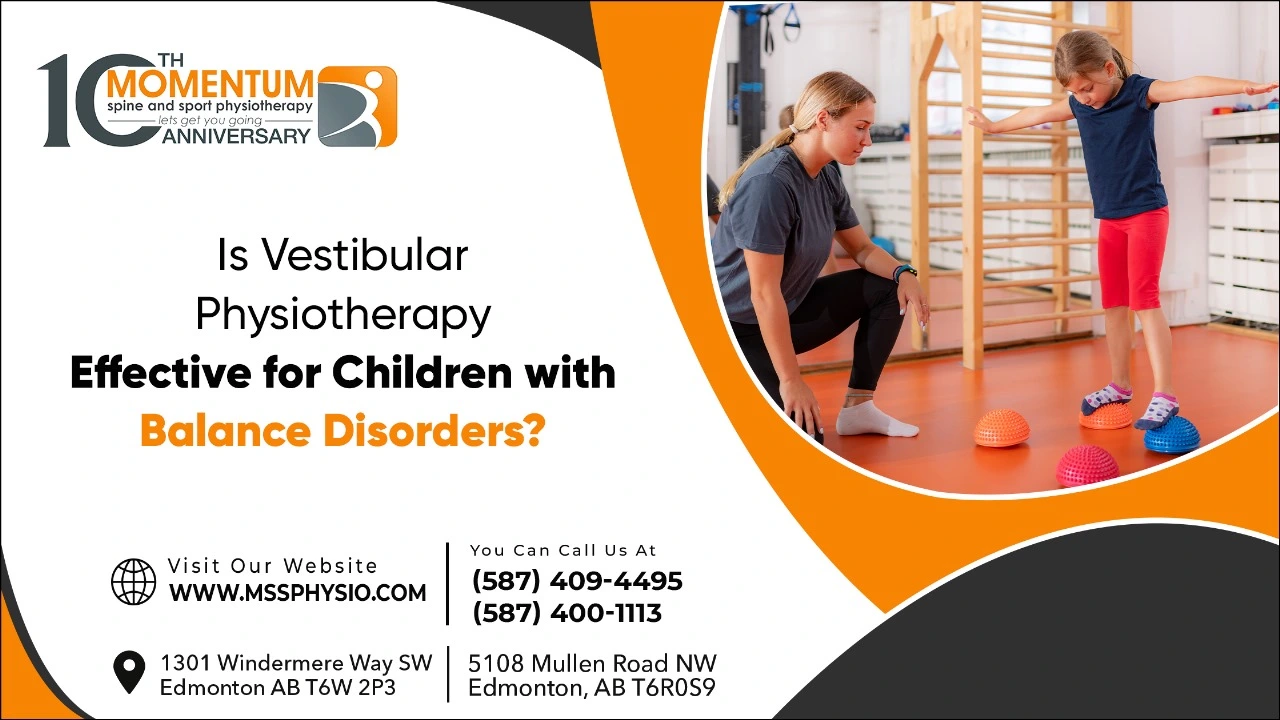Vestibular physiotherapy, also called vestibular rehabilitation therapy (VRT), aims to address disorders of the vestibular system. Vestibular physiotherapy in Windermere aims to maintain balance and spatial orientation and coordinate eye movements. It comprises structures in the inner ear and specific areas of the brain.
Common balance disorders in vestibular physiotherapy for children include:
Benign Paroxysmal Positional Vertigo (BPPV):
Benign Paroxysmal Positional Vertigo (BPPV) is a common vestibular disorder characterized by intense vertigo triggered by head movements. It occurs due to displaced calcium carbonate crystals in the inner ear’s semicircular canals, disrupting balance.
Vestibular Neuritis:
This refers to the inflammation affecting the vestibular nerve, causing vertigo, imbalance, and nausea. Vertigo, a spinning sensation, is the primary symptom, often triggered by head movements. Imbalance and nausea are common, making walking difficult.
Labyrinthitis:
Labyrinthitis is characterized by inflammation of the inner ear structures, which are crucial for both balance and hearing. This inflammation disrupts normal sensory functions, leading to a constellation of symptoms, including vertigo, hearing loss, and imbalance.
Ménière’s Disease:
This condition impacts the inner ear, marked by repeated bouts of vertigo, varying degrees of hearing loss, tinnitus, and a sense of pressure in the ear.
Concussion or Traumatic Brain Injury (TBI):
Concussion or Traumatic Brain Injury (TBI) occurs when head trauma disrupts vestibular function. These injuries may arise from various factors, including falls, accidents, or sports-related incidents, and may lead to temporary or persistent dysfunction of the vestibular system.
Tachycardia Syndrome (POTS):
This condition is characterized by an irregular elevation in heart rate upon standing, frequently accompanied by sensations of dizziness, lightheadedness, and potential fainting.
Cerebellar Disorders:
Cerebellar Disorders involve dysfunction of the cerebellum, affecting coordination and balance control, leading to symptoms such as ataxia and gait disturbances. These disorders can result from various causes, including genetic conditions or neurological diseases.
Motion Sensitivity:
Motion sensitivity, commonly observed in children, refers to the tendency to experience dizziness or nausea when exposed to motion stimuli, such as riding in a car or on a swing.
Is Vestibular Physiotherapy Effective for Children with Balance Disorders?
Yes, vestibular physiotherapy can be effective for children with balance disorders. Children can experience a range of balance disorders due to various factors, including congenital conditions, neurological conditions, inner ear problems, or injury. Vestibular physiotherapy in Windermere typically involves tailored exercises and activities designed to promote balance, coordination, and overall functional abilities for children. These exercises may include:
Balance Training:
Activities to improve static and dynamic balance, like standing on one leg, walking on balance beams, or playing games that challenge balance. Some common balance training exercises used for children include:
Static Balance Exercises:
- Single-leg stance: Standing on one leg for increasing durations of time to improve balance and proprioception.
- Tandem stance: Standing with one foot positioned directly in front of the other, positioning the heel of one foot with the toes of the other, in order to create a challenge for balance.
- Feet-together stance: Standing with feet close together to improve balance control.
Dynamic Balance Exercises:
- Walking on different surfaces: Walking on uneven surfaces, foam pads, or balance boards to challenge balance reactions.
- Walking with head movements: Walking while turning the head side to side or up and down to challenge vestibular function.
- Obstacle courses: Setting up obstacles to navigate while walking or running to improve agility and dynamic balance.
Coordination Exercises:
Tasks that promote coordination between different parts of the body, such as throwing and catching balls, jumping, or hopping. Here are some coordination exercises commonly used in this therapy:
Balance Board Exercises:
Using a balance board to perform various movements such as tilting side to side, front to back, or in circular motions. These exercises challenge proprioception and help improve balance control.
Bosu Ball Activities:
Utilizing a Bosu ball (half stability ball) for activities like standing, squatting, lunging, or performing upper body exercises. This challenges balance and coordination by introducing an unstable surface.
Visual-Motor Integration:
Pediatric physiotherapy improves the coordination between vision and body movements, which is crucial for balance and spatial orientation. Here are some examples of visual-motor integration exercises commonly used in this therapy:
Visual Tracking Exercises:
- Practicing smooth and accurate visual tracking movements to follow moving objects or targets:
- Following a moving object (e.g., a ball, a swinging pendulum) with the eyes only.
- Tracking a moving target along different trajectories (e.g., horizontal, vertical, diagonal).
Visual-Spatial Awareness Exercises:
- Improving awareness of spatial relationships and orientation through visual cues:
- Puzzle-solving tasks that require arranging objects or shapes in specific spatial configurations.
- Navigating through mazes or obstacle courses while paying attention to visual cues for direction and spatial orientation.
Empowering Pediatric Balance:
Vestibular physiotherapy in Windermere stands as a valuable intervention for children grappling with balance disorders. Vertigo physiotherapy is a specialized approach aimed at addressing vestibular disorders, including Ménière’s disease, benign paroxysmal positional vertigo (BPPV), vestibular neuritis, and other conditions affecting balance and spatial orientation. Momentum Physiotherapy in Windermere collaborates with pediatric physiotherapists or vestibular rehabilitation specialists, and individualized treatment plans are developed to address the specific needs of each child. While further research may be used to explore the long-term effects and optimize therapeutic approaches, the existing body of evidence underscores the importance of vestibular rehabilitation therapy in supporting children on their journey toward improved balance and physical well-being.
For further related information, click here.









